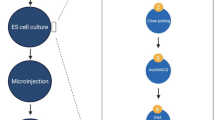Abstract
The introduction of germ line modifications by gene targeting in mouse embryonic stem (ES) cells has proven a fundamental technology to relate genes to mammalian biology. Critical aspects required for successful gene targeting have traditionally been experimental enhancements that increase the frequency or detection of homologous recombination within ES cells; however, the utilization of such methods may still result in the failed isolation of a positively targeted ES cell clone. In this study, we discuss the current enhancement methods and describe an ES cell pooling strategy that maximizes the ability to detect properly targeted ES cells regardless of an inherent low targeting efficiency. The sensitivity required to detect correctly targeted events out of a pool of ES cell clones is provided by polymerase chain reaction (PCR), and only those pools containing positives need to be expanded and screened to find individually targeted clones. This method made it possible to identify targeted clones from a screen of approximately 2,300 ES cell colonies by performing only 123 PCR reactions. This technically streamlined approach bypasses the need to troubleshoot and re-engineer an existing targeting construct that is functionally suitable despite its low targeting frequency.





Similar content being viewed by others
References
Chauhan SS, Gottesman MM (1992) Construction of a new universal vector for insertional mutagenesis by homologous recombination. Gene 120:281–285
Cruz A, Coburn CM, Beverley SM (1991) Double targeted gene replacement for creating null mutants. Proc Natl Acad Sci USA 88:7170–7174
DeChiara TM (2001) Gene targeting in ES cells. Methods Mol Biol 158:19–45
Deng C, Capecchi MR (1992) Reexamination of gene targeting frequency as a function of the extent of homology between the targeting vector and the target locus. Mol Cell Biol 12:3365–3371
Kim HS, Smithies O (1988) Recombinant fragment assay for gene targetting based on the polymerase chain reaction. Nucleic Acids Res 16:8887–8903
Mendoza LM, Paz P, Zuberi A, Christianson G, Roopenian D, Shastri N (1997) Minors held by majors: the H13 minor histocompatibility locus defined as a peptide/MHC class I complex. Immunity 7:461–472
Mortensen RM, Zubiaur M, Neer EJ, Seidman JG (1991) Embryonic stem cells lacking a functional inhibitory G-protein subunit (alpha i2) produced by gene targeting of both alleles. Proc Natl Acad Sci USA 88:7036–7040
Sarig R, Mezger-Lallemand V, Leibovitz S, Nudel U (2000) Increased efficiency of homologous recombination in ES cells by cleavage at both ends of homology in the targeting vector. Transgenic Res 9:79–80
Templeton NS, Roberts DD, Safer B (1997) Efficient gene targeting in mouse embryonic stem cells. Gene Ther 4:700–709
Tessarollo L (2001) Manipulating mouse embryonic stem cells. Methods Mol Biol 158:47–63
Thomas KR, Capecchi MR (1987) Site-directed mutagenesis by gene targeting in mouse embryo-derived stem cells. Cell 51:503–512
Udy GB, Parkes BD, Wells DN (1997) ES cell cycle rates affect gene targeting frequencies. Exp Cell Res 231:296–301
van Deursen J, Wieringa B (1992) Targeting of the creatine kinase M gene in embryonic stem cells using isogenic and nonisogenic vectors. Nucleic Acids Res 20:3815–3820
Weihofen A, Binns K, Lemberg MK, Ashman K, Martoglio B (2002) Identification of signal peptide peptidase, a presenilin-type aspartic protease. Science 296:2215–2218
Yagi T, Ikawa Y, Yoshida K, Shigetani Y, Takeda N, Mabuchi I, Yamamoto T, Aizawa S (1990) Homologous recombination at c-fyn locus of mouse embryonic stem cells with use of diphtheria toxin A-fragment gene in negative selection. Proc Natl Acad Sci USA 87:9918–9922
Acknowledgements
We are grateful to Luke Krebs for critical reading of this manuscript and Jennifer Torrance for graphical assistance. This work was supported by the National Institutes of Health grants AI28802, DK56597 and CA034196.
Author information
Authors and Affiliations
Corresponding author
Rights and permissions
About this article
Cite this article
Brown, A.C., Lerner, C.P., Graber, J.H. et al. Pooling and PCR as a method to combat low frequency gene targeting in mouse embryonic stem cells. Cytotechnology 51, 81–88 (2006). https://doi.org/10.1007/s10616-006-9021-8
Received:
Revised:
Accepted:
Published:
Issue Date:
DOI: https://doi.org/10.1007/s10616-006-9021-8




